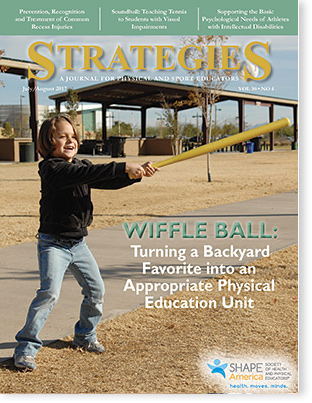 Strategies Table of Contents
Strategies Table of Contents
Wiffle Ball: Turning a Backyard Favorite into an Appropriate Physical Education Unit
Todd Layne

When people reflect on their childhood years, they will recall their
most enjoyable moments. Many times, these moments involve some type
of play. One activity that was popular — and still is today — is wiffle ball.
Since the creation of the wiffle ball in the late 1950s, the game, which incorporates the
iconic ball and yellow bat, has grown in popularity (Santora, 2003). Leagues have been created
across the United States with many forms of the game being played (Kennedy, 2000).
National tournaments have been created with teams across the nation competing against
one another. In addition, replica Major League Baseball fields and other original field ideas
have been created (Kohler, 2014) for league play and to raise money for various charities
(Devlin, 2011). Wiffle ball is a game that has been played by people from all walks of life.
Regardless of age, it is a game that all can enjoy.
Wiffle ball is intended to be fun and played by all. The physical
education classroom is a place to provide students with a
developmentally appropriate approach to learning the game.
Although wiffle ball has produced pleasant moments for some,
memories of playing the game during physical education may
not have been as satisfying for others. Often, teachers would
divide students into two teams, with each team having more
than the typical nine team members per side. Players would
have long wait times to bat and would seldom have chances
to make plays on defense. Most often, the lack of defensive
opportunities was due to the fact that two to three students
would dominate play and try to field each ball that was hit or
multiple people would be assigned to the same position. Appropriate
opportunities to practice the skills were not available
to students. The limited opportunities would lead to students not being able to strike the ball being pitched, which ultimately
increased the amount of wait time. Consequently, frustration
increased and interest in playing during school hours decreased.
Campbellball
During the early 1990s, a campus minister in Middle
Tennessee named Kelly Campbell took advantage of an opportunity
to play the game of wiffle ball. Wanting to enjoy a
childhood favorite, Kelly would organize games on Tuesday afternoons,
which happened to be one of his days off from work.
A few college students would get together and play wiffle ball
in Kelly’s backyard. The game became known as Campbellball.
In the beginning of Campbellball, players would attempt to
strike out players from the other team. They quickly realized
that it decreased the amount of activity and ultimately the fun
of the game. The rule was established that the pitcher must lob
the ball for the batter to hit. The addition of that rule immediately
increased activity and enjoyment for all players involved.
Campbellball turned into a weekly event, which continues to
be played today by people of all ages — even an 85-year-old
person has played an entire game (see
www.campbellball.com).
To read the rest of this article,
click here to download a pdf.